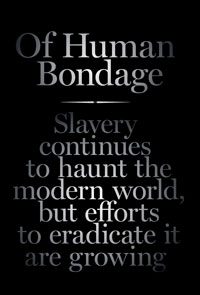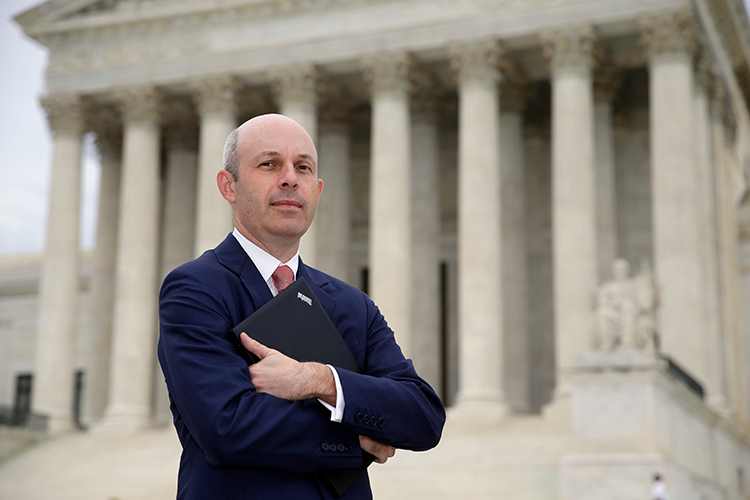Slavery continues to haunt the modern world, but efforts to eradicate it are growing

Photo by Winky Lewis
Maria watched the expensive car roll into her small town in Honduras. Two well-dressed men stepped out of the vehicle. They walked toward Maria, 15, and two friends who were with her. The men said they were recruiting people to work in a textile factory in the United States.
It sounded like a terrific opportunity—a chance for Maria to earn enough money to help her family while supporting herself. Most of all, it meant she would be able to send money to her mother, who was struggling to raise six other children on her own.
Maria agreed to go with the men. So did her two friends.
When the girls arrived in Houston, however, they weren’t brought to a textile factory. Instead, they were held captive, beaten, raped and forced to work in cantinas that doubled as brothels. When a man came to a cantina, he would choose a girl and drink beer with her. If he decided he wanted sex, he would take her to the back and pay for a mattress, paper towels and spermicide. If a girl didn’t bring in enough money on a given day, her captors would beat her.
That was Maria’s life for six long years. Finally, an American family helped her to escape. Maria managed to return to her family in Honduras. But she hasn’t seen her two friends since fleeing Houston; and for all she knows, they’re still there working in cantinas and enduring the beatings of their captors.
Maria is one face of the modern scourge of human slavery—but only one. There are millions more people like her around the world. They are children and adults, men and women. They are someone’s daughter or son, brother or sister, mother or father.
The victims of slavery populate the world’s sex trade, but they also exist in many other sectors of the international economy. Forced labor occurs in domestic work, landscaping, nail salons, industrial cleaning, food processing and agricultural work, garment production and other factory settings, as well as restaurants. Some governments impose forced labor on their citizens. And in some countries, children are unlawfully coerced or forced to become soldiers.
More than 100 different products were included on the U.S. Department of Labor’s 2009 List of Goods Produced by Child Labor or Forced Labor (PDF), including coffee and tea, cotton, gold and diamonds, fireworks, clothing and shoes, various foodstuffs, soap, soccer balls, surgical instruments, pornography—even Christmas decorations.
Some 20.9 million people around the world are victims of sex trafficking and other types of forced labor, according to the Estimate of Forced Labour report (PDF) released in 2012 by the International Labour Organization, an agency of the United Nations. The comparable number in the ILO’s 2005 report was 12.3 million. (Other estimates put the number of forced labor victims as high as 27 million.)
In effect, the ILO’s estimate means that about three out of every 1,000 people inhabiting the planet are victims of modern slavery.
The ILO report estimates 18.7 million of the world’s forced-labor victims are exploited in the private economy. Some 55 percent of those people are women and girls, including 98 percent of the victims of sexual exploitation and 40 percent of those enslaved by other forms of forced labor in the private economy.
Some 4.5 million people, or 22 percent of all enslaved workers, are victims of forced sexual exploitation, according to the ILO report. Another 14.2 million, or 68 percent, are victims of forced-labor exploitation in such economic activities as agriculture, construction, domestic work and manufacturing. The remaining 2.2 million, or 10 percent, are victims of state-imposed forms of forced labor.
No region of the world is free from slavery. The ILO report estimates that there are some 11.7 million victims of sexual exploitation, labor exploitation or state-imposed forced labor in China, India and the rest of Asia (excluding Japan). There are another 3.7 million in Africa; 600,000 in the Mideast; 1.8 million in Central and South America; 1.6 million in Eastern Europe and the former Soviet Union; and 1.5 million in the United States, Canada, Australia, Japan, New Zealand and Western Europe.

A SILENT CRIME
There are no firm estimates for the number of slavery victims in the United States, but there is no dispute among government officials and advocacy groups that it occurs within this country at a disturbing rate.
“The United States is a source, transit and destination country for men, women and children—both U.S. citizens and foreign nationals—subjected to forced labor, debt bondage, involuntary servitude and sex trafficking,” states the 2012 Trafficking in Persons Report produced by the State Department.
“We have a scourge that needs to be eradicated, but it is a silent crime,” says ABA President Laurel G. Bellows, who put the issue at the top of her agenda when she started her one-year term in August 2012. Every year, “we have approximately 100,000 U.S. citizens who are being forced into labor or sex for the profit of their captors, and many more people than that are brought into this country for those purposes,” says Bellows, who is principal of the Bellows Law Group in Chicago. “This is modern-day slavery within the borders of our own country.”
Modern-day slavery is more commonly known by the terms human trafficking or trafficking in persons, despite the objections of some experts in the field.
“We use ‘human trafficking’ because it is the popular nom de guerre, but this is old-fashioned slavery. Calling it human trafficking gives it a sanitized name,” says Claude d’Estrée, a professor at the University of Denver and director of the school’s Human Trafficking Clinic.
But the modern terminology also helps draw a distinction between the chattel slavery that existed through most of human history, in which a slave was “owned” by his or her master, and today’s version, which in some ways is more insidious because its nature makes it harder to identify.
The U.S. Trafficking Victims Protection Act (PDF), passed by Congress in 2000, defines two primary human trafficking crimes: (1) Sex trafficking, in which a commercial sex act is induced by force, fraud or coercion, or in which the person induced to perform such an act is not yet 18 years old and (2) the recruitment, harboring, transportation, provision or obtaining of a person for labor or services through use of force, fraud or coercion for the purpose of subjecting that person to involuntary servitude, peonage, debt bondage or slavery.
The actual physical transport of a victim from one location to another is not necessary under the act to meet the definitions of these crimes under the Trafficking Victims Protection Act.
Traffickers often do transport victims from one place to another to meet demand and to isolate their victims. Many victims, however, are enslaved close to home; and others move to new and unfamiliar locations on their own, where they become easier victims for traffickers.
Modern-day slavery is not typically a permanent condition—although that may come as meager consolation to victims.

Photo by Winky Lewis
PRISON THROUGH COERCION
There really is no distinction between sex trafficking and forced labor, says Martina E. Vandenberg, who last year founded the Human Trafficking Pro Bono Legal Center in Washington, D.C. “What you lose is your freedom,” says Vandenberg, who is a member of the ABA Task Force on Human Trafficking appointed by Bellows. “What you lose is your choice to make any decision about your personal movement. You’re being held in what amounts to prison through coercion.”
Shonnie R. Ball, the interagency liaison for the State Department’s Office to Monitor and Combat Trafficking in Persons, recently described the terror that trafficking victims can encounter in another way. Coercion doesn’t require physical actions by captors; instead, “what’s important is the chain on your brain. It’s the fear of what might happen,” said Ball, speaking in February at a program on human trafficking sponsored by the ABA’s Judicial Division during the association’s 2013 midyear meeting.
But terminology doesn’t change the fact that modern-day trafficking is a form of slavery.
In a speech last fall that many activists view as a seminal moment in the growing fight against human trafficking, President Barack Obama pulled no punches in describing the true nature of the issue. Speaking Sept. 25 at a meeting in New York City of the Clinton Global Initiative created by the former president, Obama said, “I’m talking about the injustice—the outrage—of human trafficking, which must be called by its true name: modern slavery.”
Noting that the 150th anniversary of President Abraham Lincoln’s announcement of the Emancipation Proclamation had occurred only a few days earlier, Obama said, “Now, I do not use that word, slavery, lightly. It evokes obviously one of the most painful chapters in our nation’s history. But around the world, there’s no denying the awful reality.
“When a man, desperate for work, finds himself in a factory or on a fishing boat or in a field, working, toiling, for little or no pay, and beaten if he tries to escape—that is slavery. When a woman is locked in a sweatshop, or trapped in a home as a domestic servant, alone and abused and incapable of leaving—that’s slavery. When a little boy is kidnapped, turned into a child soldier, forced to kill or be killed—that’s slavery. When a little girl is sold by her impoverished family—girls my daughters’ age—runs away from home or is lured by the false promises of a better life, and then imprisoned in a brothel and tortured if she resists—that’s slavery. It is barbaric, and it is evil, and it has no place in a civilized world.”
In conjunction with Obama’s speech, the White House announced a series of steps to bolster the administration’s efforts to fight human trafficking. Those initiatives include:
• An executive order directing that government contracts prohibit contractors and subcontractors from engaging in activities that amount to human trafficking.
• More training to help federal prosecutors, law enforcement agencies and immigration judges—along with their partners at the state and local levels—to detect trafficking and avoid treating trafficking victims as criminals.
• Increased resources and services for trafficking victims, including easier access to T-visas, which allow victims to remain in the United States and aid the prosecution of their traffickers.
• The creation of the Global Business Coalition Against Trafficking to help mobilize private businesses.
• The creation of a comprehensive plan for future action by the President’s Interagency Task Force to Monitor and Combat Trafficking in Persons.
Obama’s speech, in concert with other action on the issue, has encouraged a growing mood of optimism. The other action includes stepped-up efforts to address human trafficking by the ABA and a growing number of other nongovernmental organizations at the national and international levels, actions by Congress and the states to encourage greater law enforcement efforts, U.N. initiatives, and increased recognition of the problem by the private business sector.
“This is a solvable problem. This could be a slave-free country and a slave-free world,” says Kevin Bales, one of the co-founders of Free the Slaves, based in Washington, D.C. “With the will and some resources, we can end this.”
But the forces coming together to fight human trafficking are up against an implacable foe. Eradicating modern slavery “will require enormous effort,” says d’Estrée. “The more time I spend doing this, the more complex it is. There is no simple or single solution.”

Photo by Winky Lewis
A LUCRATIVE VENTURE
Human trafficking is extremely profitable. It generates some $32 billion per year, making it the second-largest criminal activity in the world, behind only drug dealing, and the fastest-growing, according to the National Association of Attorneys General. And human trafficking has a unique advantage: Unlike drug dealing and weapons trafficking—other leading crimes around the world—the victims of human trafficking can produce profits over and over again.
“A sex slave can be sold repeatedly in the same day. A wage slave produces products for free,” says Derri Smith, executive director of End Slavery Tennessee, based in Nashville.
Also, human trafficking is a relatively safe criminal endeavor, due to a combination of ineffective and underfunded enforcement efforts, along with victims who are unwilling or unable to assert themselves. And there is a ready supply of potential victims.
Most population growth “is in the developing world, and in many parts of that world there are high levels of conflict and poverty, and there’s little rule of law,” Bales says. “That created a large pool of potentially enslavable people.”
The collapse of the Soviet bloc in the late 1980s, for instance, produced a bumper crop of potential trafficking victims, both for the sex trade and other areas of commercial exploitation.
A growing awareness of the sex trade in the Russian Federation, a remnant of the Soviet Union, drew Vandenberg to the human trafficking issue. In the early 1990s, she was studying the Russian military when she met a woman who had been raped. The authorities, the woman recounted, told her to “just sleep it off.” Vandenberg switched gears and opened a rape crisis center. Later, she worked with Russian women who had been trafficked to Israel and forced into prostitution. Starting in the late 1990s, she also worked with Russian women who had been brought to Bosnia and Herzegovina to work as prostitutes.
“The women knew the prices for which they had been sold,” says Vandenberg, “and they had to work that off to gain their freedom. But that rarely worked in reality.” Instead, their captors would just sell the women again, and they would have to start working all over again in efforts to buy back their freedom.
Meanwhile, the tactics used by traffickers to control their victims—both physical and psychological—often keep them from going to the authorities, even if they might be able to. Trafficking victims are told that if they misbehave in any way, their husbands, wives, children, siblings and parents will be beaten, raped, maimed or even killed. These are not empty threats.
Moreover, many victims of slavery are captives in strange lands. They often don’t speak the local language or even know where they are—making it difficult to seek help. Traffickers typically take away any identification documents from their victims, who believe that seeking official help will only result in their being jailed and deported as illegal immigrants. And all too often, that’s exactly what happens when authorities uncover a trafficking operation.
Besides, many trafficking victims don’t expect to get much help from law enforcement and the courts. “The amount of corruption in some countries is just out of control. Immigration officers are involved in visa fraud. Police are involved in trafficking rings,” says Luz Estella Nagle, a professor at Stetson University College of Law in Gulf-port, Fla., and a past co-chair of the International Committee in the ABA’s Criminal Justice Section.
Those perceptions can affect cases in the United States, notes Vandenberg. “Many clients believe the American legal system is corrupt just like the legal systems in their countries of origin,” she says.
TWO KEY MOVES
Consensus is growing among government officials, advocacy groups and the business community that an effective response to human trafficking must focus on providing better support services for victims while pursuing tougher enforcement efforts against traffickers. There’s plenty of work to do on both fronts.
In October 2000, Congress passed the Trafficking Victims Protection Act, which emphasizes what government officials refer to as the “3 P’s”: prosecution, protection and prevention. The act made it a federal crime to induce a person to engage in forced labor or a commercial sex act through force, fraud or coercion. In addition, any person under the age of 18 who performs a commercial sex act is considered a human trafficking victim regardless of whether force, fraud or coercion was present.
Further, the act established the State Department’s Office to Monitor and Combat Trafficking in Persons and directed that office to issue annual reports that contain sum-maries of efforts by nations around the world (including the United States) to fight human trafficking; and authorized the federal government to impose sanctions on nations that fail to combat slavery.
The act also authorized special services for human trafficking victims and introduced the T-visa, which permits some victims who assist in the prosecution of their traffickers to remain in the United States. (The act was reauthorized in 2003, ’05 and ’08, and Congress is expected to consider another reauthorization this year.)
Six weeks after the Trafficking Victims Protection Act became law, the U.N. also acted. A conference in Palermo, Italy, produced two protocols to the Convention Against Transnational Organized Crime. One was the “Protocol to Prevent, Suppress and Punish Trafficking in Persons, Especially Women and Children.” (PDF) The protocol entered into force on Dec. 25, 2003. As of June, 150 nations were party to it, including the U.S., which ratified it in 2005.
The key contribution of the Palermo protocol was to put forth for the first time a definition of trafficking that could provide the basis for laws at the national and international levels. Taking an approach similar to the U.S. law, the protocol defines “trafficking in persons” as “the recruitment, transportation, transfer, harboring or receipt of persons, by means of the threat or use of force or other forms of coercion, of abduction, of fraud, of deception, of the abuse of power or of a position of vulnerability or of the giving or receiving of payments or benefits to achieve the consent of a person having control over another person, for the purpose of exploitation.”
The Palermo protocol produced mixed results. It galvanized many nations to enact anti-trafficking laws. In 2003, just 52 nations had some form of the laws; but by 2010, 128 countries had enacted laws prohibiting all forms of human trafficking, according to the State Department’s 2011 Trafficking in Persons Report.
But enforcement of these laws has lagged. In 2007, there were 5,682 human trafficking prosecutions and 3,427 convictions around the world, according to the State Department’s 2012 report. Of those totals, 490 prosecutions and 326 convictions involved forced labor outside of the sex trade. By 2011, those numbers had only edged up to 7,206 prosecutions (508 outside the sex trade) and 4,239 convictions (320 outside the sex trade).
The numbers for the U.S. also are disappointing. In federal fiscal year 2011, about 2,000 human trafficking cases were investigated by the Justice Department, the FBI, and Immigration and Customs Enforcement, according to the 2012 Trafficking in Persons Report. During the same year, the Justice Department prosecuted only 42 cases of forced labor or sex trafficking involving adult victims. That number increased to 125 when cases involving sex trafficking of minors were added in. Federal prosecutors obtained a total of 151 convictions in FY 2011, an increase of 10 over FY 2010.
There are a number of reasons for the low rates of human trafficking prosecutions in the United States and other countries. Sometimes trafficking victims disappear into the fabric of a nation’s culture and traditions. Douglas Kramer, a retired lawyer in New York’s Hudson Valley who volunteers through the ABA Rule of Law Initiative to work on human trafficking issues in various countries, experienced that phenomenon firsthand. “In Mongolia, a poor family will often sell a child to a wealthier family to help herd sheep,” he says. “The child doesn’t go to school; he just works. This is how things have been done for a long time.”
Kramer helped local police set up a special anti-trafficking unit whose members readily went after criminals who were kidnapping schoolgirls off the street and forcing them into prostitution. But the officers didn’t comprehend that forcing someone to work as a shepherd also amounted to slavery, Kramer says.
Officials often are reluctant to expend limited resources on human trafficking cases because they are time-consuming, expensive and difficult.
Bales recalls being told by one FBI agent: “If I open the back of a van and see 16 people who look beaten and confused, but they don’t speak my language, I don’t know who’s the victim and who’s the perpetrator. I do know that investigating the case will burn my time in a way that will make my supervisor unhappy.”
Some activists maintain that the reasons why human trafficking isn’t a higher priority go deeper than considerations like resources and time.
A key factor is that the U.S. political structure, legal system and society in general have failed to come to terms with a pervasive epidemic of violence against women, which fuels both the sex trade and other forms of labor trafficking, according to Norma Ramos, executive director of the Coalition Against Trafficking in Women, based in New York City, and a member of the ABA’s Human Trafficking Task Force. Ramos spoke at the Judicial Division’s program during the ABA Midyear Meeting.
“We’ve been arresting the wrong people. We’ve been arresting the victims,” she said. “Until we make an end of violence against women a priority, we won’t solve this problem.”
The State Department’s trafficking report for 2010 cited a similar factor: “The victims of this crime are perceived to be society’s throwaways—prostitutes, runaways, the poor, racial or ethnic minorities, members of a low caste or recent immigrants.” Officials simply aren’t that interested in committing extensive resources to protecting these people, the report noted.
THE ARSENAL GROWS
Despite those concerns, significant steps are being taken to reinforce the fight against human trafficking, in some cases with new approaches.
When Congress reauthorized the Trafficking Victims Protection Act in 2003, it included a provision allowing trafficking victims to pursue civil actions against their captors in some cases. The grounds are essentially the same as in criminal prosecutions—involuntary servitude, forced labor, trafficking by coercion—but there is a lower burden of proof. The act doesn’t specify damages, but the norm in cases filed so far has been to seek compensatory and punitive damages. The act does provide specifically for fee shifting.
Vandenberg recognized the promise of pursuing civil claims against traffickers early on. At the time, she was working on trafficking cases on a pro bono basis while practicing at Jenner & Block. It was often frustrating, she says, to have a client eager to work with prosecutors, only to see them drop the case. But when the civil cause of action was added to the act, “we soon realized what a powerful tool that was, but also how few people were using it.”
In one of Vandenberg’s first trafficking cases at Jenner, she represented a woman from Tanzania who had been held for four years as a domestic servant by one of her country’s diplomats posted in Washington, D.C. Vandenberg won an award of more than $1 million for her client.
The victory was bittersweet because a decade later, Vandenberg’s client still hasn’t received her judgment. Nevertheless, says Vandenberg, when the judgment was announced, “it was one of the happiest days of my life. We had a kind of acknowledgment that we thought was impossible to achieve.”
Vandenberg was a partner at Jenner when she left the firm in late 2011 and, supported by a fellowship from the Open Society Foundation created by George Soros, used the next several months to organize the Human Trafficking Pro Bono Legal Center in Washington, which went into operation in October. It will focus on civil cases against traffickers.
In setting up a database, Vandenberg found only 84 civil cases against traffickers, but she believes civil actions will be an important tool in the future. “We’re not going to prosecute our way out of human trafficking,” she says. “I think civil actions are the missing link in the U.S. fight against trafficking.”
Private businesses are being recruited into the fight against human trafficking. Obama’s executive order, issued in September in concert with the End Human Trafficking in Government Contracting Act (recently passed by Congress as part of the National Defense Authorization Act), will require government contractors to show they are not engaged in activities that contribute to or benefit from forced labor, said Mary C. Ellison, a panelist at the program during the ABA Midyear Meeting.
Together, those measures “will change the face of government procurement, really, around the world,” said Ellison, the director of policy for the Polaris Project in Washington, D.C.
Fellow panelist T. Markus Funk agreed that the corporate sector is becoming a key player in the fight against human trafficking. “The business community will be one of the most important change-makers in the human trafficking area in at least 20 years,” said Funk, a partner at Perkins Coie in Denver who co-chairs the firm’s corporate social responsibility and supply chain practice. Along with Ellison, he serves on the ABA Task Force on Human Trafficking.
But it won’t be easy, Funk cautioned. He noted that California and some other states are starting to pass their own laws requiring companies to disclose what they’re doing to address the use of forced labor up and down their production and supply chains. That can be a daunting task, he said, when a typical consumer product, say a pair of shoes, might involve 3,000 different suppliers.
Funk said companies are watching closely for the federal government to issue rules and regulations for carrying out President Obama’s executive order. The first version was expected to be issued in March.
Another goal is to bolster human trafficking laws at the state level, where most enforcement efforts against traffickers are likely to take place in the coming years.
Every state has adopted some form of anti-trafficking legislation, but “current laws are all over the map,” says Michael S. Greco, a past ABA president who now chairs the advisory committee to the association’s Center for Human Rights.
This inconsistent patchwork of laws hinders prosecution of traffickers, says Greco, who is of counsel to K&L Gates in Boston. “Greater uniformity is key to attacking human trafficking in the U.S., so trafficking doesn’t just shift from one state to another.”
A committee of the National Conference of Commissioners on Uniform State Laws is in the process of drafting a uniform act on human trafficking. A final version is expected to be completed later this year.
CHANGE AND SUPPORT
In February, the ABA House of Delegates adopted a series of resolutions sponsored by the Criminal Justice Section that are intended to help bring more uniformity to anti-trafficking laws while bolstering efforts to support victims. The resolutions urge lawmakers at all levels to enact laws:
The resolutions also urge bar associations, law schools and other legal assistance providers to establish pro bono programs to assist victims of human trafficking; and to develop training programs to help judges, lawyers and others in the legal system identify adult and minor victims of human trafficking, and steer them to support services.
Such measures are vital, says ABA President Bellows, because “until we offer necessary protections, we won’t eradicate this problem.”
But ultimately, she says, the key to defeating human trafficking is to recognize its existence. “When people learn their children and fellow citizens are slaves in this country,” she says, “they will wake up, and that’s what is happening now.”
Steven Seidenberg is an attorney and freelance reporter in the greater New York City area.



